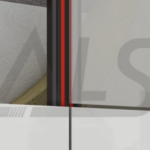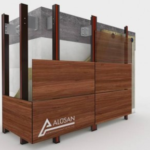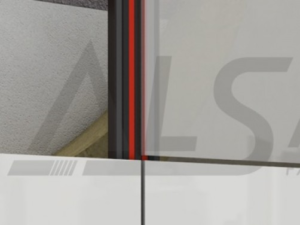Ceramic Facade Cladding: Revolutionizing Modern Architecture
Reading time: 9 minutes
Introduction
In the ever-evolving world of architecture and building design, ceramic facade cladding has emerged as a revolutionary solution, transforming the way we approach exterior finishes. This innovative technology marries the timeless elegance of ceramics with cutting-edge engineering, offering a multitude of benefits that extend far beyond mere aesthetics. As urban landscapes continue to evolve and sustainability becomes increasingly crucial, ceramic facade cladding stands at the forefront of architectural innovation, promising durability, versatility, and eco-friendliness.
A Brief History of Facade Cladding
The concept of facade cladding dates back centuries, with various materials used to protect and beautify building exteriors. From traditional wooden sidings to stone veneers, each era brought its own preferences and technological advancements. The introduction of ceramic cladding in the mid-20th century marked a significant leap forward, offering unprecedented durability and design flexibility. As manufacturing techniques improved and sustainability concerns grew, ceramic cladding evolved to become the sophisticated system we see today, capable of meeting the complex demands of modern architecture.
Key Benefits of Ceramic Facade Cladding
Unparalleled Durability and Weather Resistance
One of the primary advantages of ceramic facade cladding is its exceptional durability. Engineered to withstand extreme weather conditions, from scorching heat to freezing temperatures, ceramic tiles resist fading, cracking, and chipping. This resilience ensures that buildings maintain their aesthetic appeal for decades, significantly reducing maintenance costs and frequency.
Aesthetic Versatility
Ceramic cladding offers an unprecedented range of design possibilities. Available in a vast array of colors, textures, and finishes, it allows architects to bring their most ambitious visions to life. From sleek, monochromatic designs to intricate patterns and textures mimicking natural materials, the versatility of ceramic tiles enables the creation of truly unique facades that can complement any architectural style or urban setting.
Enhanced Energy Efficiency
Modern ceramic facade systems contribute significantly to a building’s overall energy efficiency. The ventilated facade technique commonly used with ceramic cladding creates an air chamber between the building’s structure and the exterior tiles. This design not only aids in temperature regulation but also helps manage moisture, reducing heating and cooling costs while improving indoor comfort.
Applications in Modern Architecture
Ceramic facade cladding finds application across a wide spectrum of architectural projects, from residential buildings to commercial complexes and public institutions. In high-rise residential developments, it offers a low-maintenance, aesthetically pleasing solution that can significantly enhance property values. Commercial buildings benefit from the material’s ability to create striking first impressions while ensuring long-term durability. Educational institutions and healthcare facilities often choose ceramic cladding for its hygienic properties and ease of maintenance, crucial factors in high-traffic public spaces.
Installation Techniques and Considerations
The installation of ceramic facade cladding requires precision and expertise. Modern systems typically employ a ventilated facade technique, which involves creating an air gap between the building’s wall and the ceramic tiles. This method not only enhances energy efficiency but also protects the building’s structure from moisture and temperature fluctuations. Specialized mounting systems ensure proper alignment and secure attachment of tiles, allowing for thermal expansion and contraction. While the initial installation may be more complex compared to traditional cladding methods, the long-term benefits in performance and durability more than justify the investment.
Maintenance and Longevity
One of the most appealing aspects of ceramic facade cladding is its minimal maintenance requirements. The non-porous nature of ceramic tiles makes them resistant to staining and easy to clean, often requiring nothing more than periodic washing with water to maintain their appearance. This low-maintenance characteristic not only reduces ongoing costs but also ensures that the building’s exterior remains attractive with minimal effort. The longevity of ceramic cladding, often exceeding 50 years, makes it a cost-effective choice in the long run, despite potentially higher initial investment compared to some traditional materials.
Sustainability and Environmental Impact
In an era where sustainability is paramount, ceramic facade cladding stands out as an environmentally responsible choice. Made primarily from natural clay and other minerals, ceramic tiles are recyclable and do not emit volatile organic compounds (VOCs). The production process has seen significant improvements in energy efficiency and waste reduction, further minimizing the environmental footprint. Additionally, the energy-saving properties of ceramic cladding systems contribute to reduced carbon emissions over the building’s lifetime. Many ceramic cladding products now come with environmental product declarations (EPDs), allowing architects and builders to make informed decisions aligned with green building standards.
The Future of Ceramic Facade Cladding
The future of ceramic facade cladding looks promising, with ongoing research and development focusing on enhancing its properties and expanding its applications. Innovations in nanotechnology are leading to the development of self-cleaning and air-purifying ceramic surfaces, which could revolutionize urban environments. Advancements in digital printing technologies are pushing the boundaries of design possibilities, allowing for even more intricate and customized facade patterns. As the construction industry moves towards more sustainable practices, the role of ceramic cladding in creating energy-efficient, long-lasting buildings is likely to grow, cementing its position as a key material in the future of architecture.
Conclusion
Ceramic facade cladding represents a perfect synthesis of form and function in modern architecture. Its ability to combine aesthetic appeal with practical benefits such as durability, energy efficiency, and low maintenance makes it an ideal choice for a wide range of building projects. As we look towards a future where sustainable, resilient, and beautiful buildings are not just desired but necessary, ceramic facade cladding stands ready to meet these challenges. For architects, developers, and property owners alike, investing in ceramic cladding is not just a choice for today, but a commitment to the longevity and sustainability of our built environment for generations to come.




Leave a reply